300 feet might sound like a lot. But what does it actually look like in real life?
Most people hear the number and think of distance or height. Still, it’s hard to picture without something familiar.
If you’ve ever walked across a football field or seen a large airplane, you’ve been near something that big. You just may not have realized it.
This guide will show you exactly how long or tall 300 feet is using real examples. From buildings and animals to sports fields and vehicles, you’ll see what 300 feet really looks like.
By the end, you’ll be able to visualize it clearly without needing any tools or measurements.
What Does 300 Feet Look Like in Real Life?
Visualizing 300 feet is easier when you compare it to things you already know.
Think of a football field. Without the end zones, it’s almost exactly 300 feet long. If you’ve stood on one, you’ve seen that distance.
These comparisons show that 300 feet isn’t rare. You pass by it more often than you think. You just need the right reference to see it clearly.
300 Feet in Other Units
| Unit | Equivalent | Real-World Reference |
|---|---|---|
| Meters | 91.44 meters | Close to the length of an international soccer field |
| Yards | 100 yards | Exact length of a football field (excluding end zones) |
| Inches | 3,600 inches | Helps understand scale in small, precise measurements |
| Miles | 0.057 miles | Slightly more than a city block |
| Kilometers | 0.091 kilometers | Useful for tracking short distances on GPS |
Inches to Feet Converter
Feet: 0 ft
These conversions help place 300 feet into units you might use in daily life, sports, or navigation.
What Does 300 Feet Tall Look Like From the Ground Up?
Looking up at something 300 feet tall creates a different sense of scale. It’s not just about size. It’s about how that size makes you feel when you’re standing beneath it.
These structures show what 300 feet of height really looks like in real life.
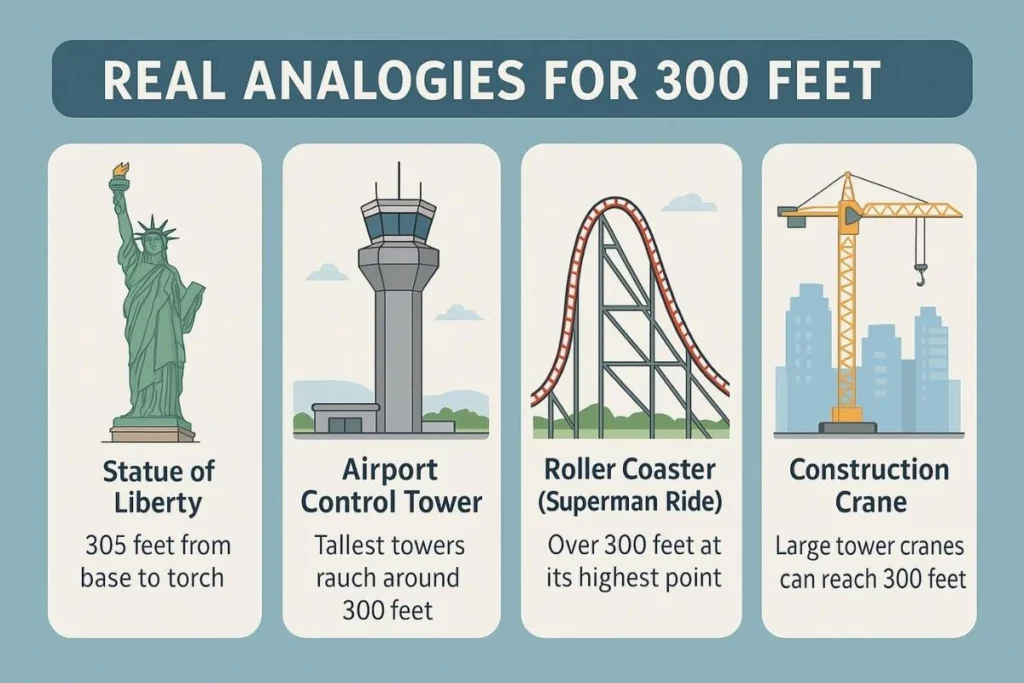
Statue of Liberty
From the ground to the tip of the torch, the Statue of Liberty measures about 305 feet.
If you’ve ever visited Liberty Island, you’ve likely felt how towering and complete that height appears from the base.
Airport Control Towers
Some of the tallest air traffic control towers in the U.S., like the one at Hartsfield-Jackson Atlanta International, rise close to 300 feet.
These towers aren’t built for aesthetics. They’re designed to give controllers a full view of multiple runways and taxiways from one place.
Roller Coasters
Certain roller coasters, such as “Superman: Escape from Krypton” in California, reach heights over 300 feet.
When riders reach the top and look down, the view gives a strong sense of how high that distance truly is. From the ground, the structure looks sharp and intimidating.
Construction Cranes
Tower cranes used on large commercial builds can extend over 280 feet, sometimes reaching or exceeding 300 feet depending on the project.
Walking beneath one makes the vertical scale feel immediate, especially when you realize how thin and tall the steel framework is.
Wind Turbines
Modern utility-scale wind turbines often stand at about 300 feet to the hub.
Add the rotating blades and the full height is even more dramatic. From the ground, they appear to turn slowly, but each sweep covers massive space.
How Far Is 300 Feet on the Field?
On a sports field, 300 feet isn’t just a number. It’s something you run, throw, or swim across. That makes it one of the easiest ways to understand the distance.
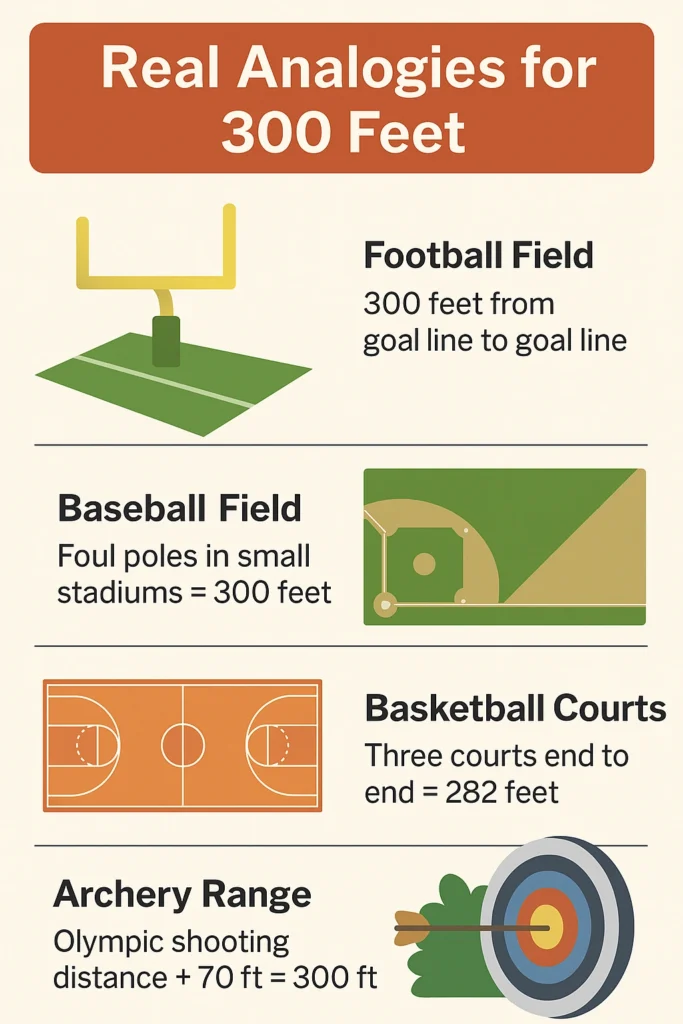
Football Field Without End Zones
An American football field, not counting the two 10-yard end zones, is exactly 300 feet long.
From one goal line to the other, that’s the full stretch. If you’ve walked or run that length, you’ve experienced 300 feet with your own steps.
Baseball Field Dimensions
In smaller stadiums, the distance from home plate to the left or right field foul pole is often around 300 feet.
A ball that clears that wall counts as a home run. That shows how much power it takes to cross 300 feet through the air.
Basketball Courts End to End
A standard basketball court is 94 feet long.
Lining up three of them gets you just under 300 feet. For players doing full-court sprints, that’s a tiring back-and-forth three times over.
Archery Target Range
Olympic archers shoot from a distance of 70 meters, which is about 230 feet.
Add another 70 feet and you’re at 300. That extra length makes precision even more difficult, especially with outdoor wind or light changes.
Swimming Pool Lengths
A standard 25-meter pool is used in many local competitions.
Six lengths of that pool total roughly 300 feet. For an average swimmer, that means several turns and a full-body workout.
Sports turn 300 feet into action. Whether you’re sprinting, shooting, or swimming, this distance shows up in real effort and performance.
What Would 300 Feet of Nature Look Like?
Nature offers some of the most powerful and memorable ways to understand distance. Living creatures and natural structures give context that’s both real and relatable.
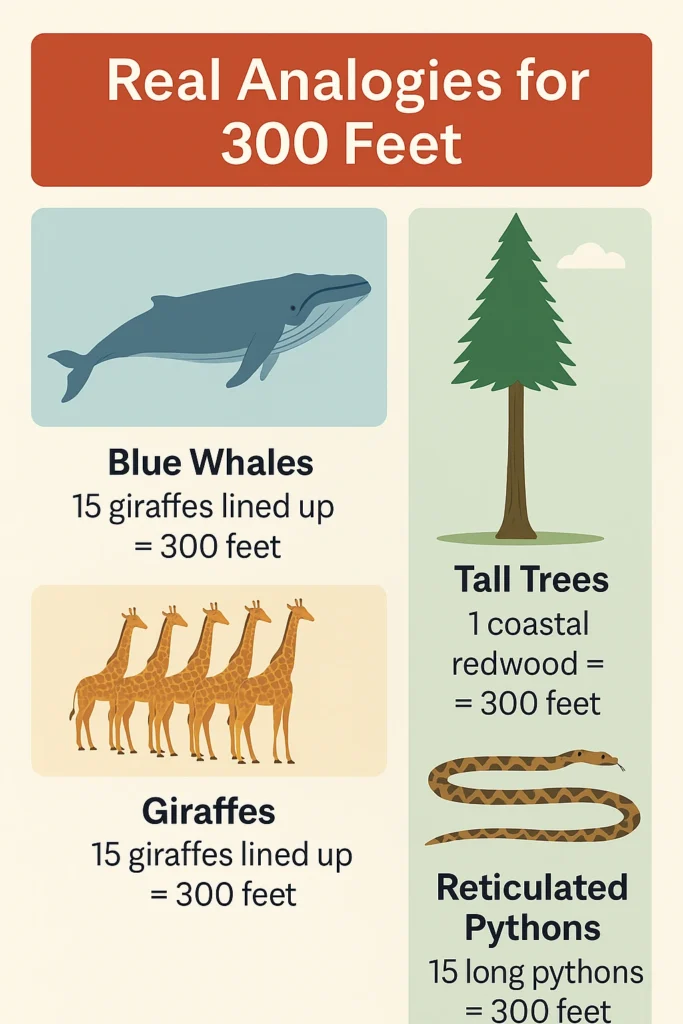
Blue Whales End to End
The blue whale is the largest animal on Earth. Adults can reach up to 100 feet in length.
Lining up three of them gives you a clear and impressive picture of 300 feet. That’s the kind of scale you’d see in deep ocean documentaries or marine exhibits.
Giraffes in a Line
An adult giraffe stands about 16 to 20 feet tall.
If you lined up 15 of them side by side, you’d cover about 300 feet. While not a common sight, the comparison works because people recognize how tall giraffes really are.
Great White Sharks
A large great white shark can measure up to 20 feet.
Fifteen sharks in a row would span 300 feet. While they’d never gather that way in real life, the number still helps you visualize underwater scale.
Pythons on the Ground
Reticulated pythons are among the longest snakes and can grow over 20 feet.
Place 15 of them end to end, and you’ll get 300 feet of length. It’s an unusual way to measure space, but it works in terms of raw numbers.
Tall Trees in the Wild
Coastal redwoods in California can grow well over 300 feet.
Unlike other examples, this one doesn’t require multiples. Just one tree can give you the full sense of that height when you stand at its base and look up through the canopy.
Nature scales distances in a way we can feel. These examples connect 300 feet to the world beyond buildings and machines.
How Long Is 300 Feet in Transportation and Vehicles?
Transportation offers some of the most practical examples of what 300 feet looks like in motion or at rest.
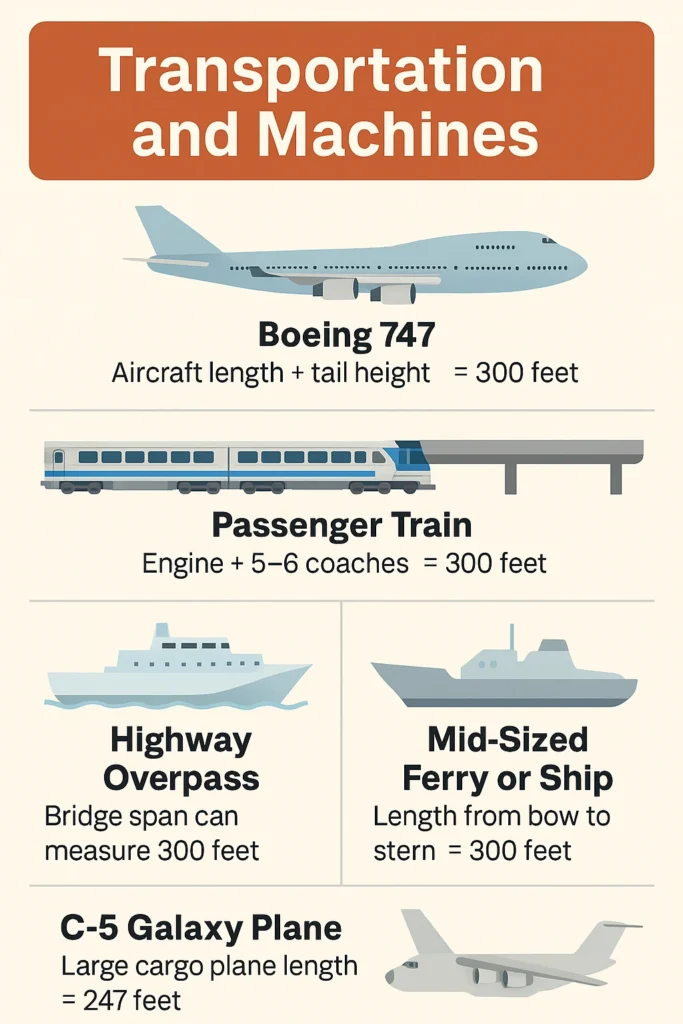
These comparisons give scale through machines we see, board, or drive near regularly.
Boeing 747 Length
A Boeing 747 is about 250 feet from nose to tail. Its vertical tail adds height, pushing the total scale closer to 300 feet.
Standing beside one on the tarmac shows how much ground this aircraft covers.
Passenger Trains
A typical Amtrak passenger train, with an engine and five to six standard coaches, can reach about 300 feet in length.
If you’ve walked along a train at a station, you’ve already experienced that distance.
School Buses in a Row
A full-size school bus is usually between 35 and 45 feet long.
Lining up seven of them brings you near the 300-foot mark. You might see a similar setup near schools during drop-off or pickup.
Highway Overpasses
Some highway bridges and off-ramps stretch about 300 feet across. Drivers often cross these without realizing how long they really are from end to end.
Mid-Sized Ships or Ferries
Not all ships are massive. Many mid-sized ferries or military vessels fall into the 250 to 300-foot range. Walking across one from bow to stern gives a full sense of the span.
Military Cargo Planes
Aircraft like the C-5 Galaxy measure around 247 feet in length. Their wingspan approaches 222 feet.
On a runway, this type of plane easily fills the space needed to imagine 300 feet.
Vehicles and structures in transportation help you grasp 300 feet by showing it in action, whether it flies, rolls, or floats.
Everyday Visual Analogies for 300 Feet
Some of the most relatable ways to picture 300 feet come from everyday surroundings. These examples use familiar spaces and objects to turn the number into something visible.
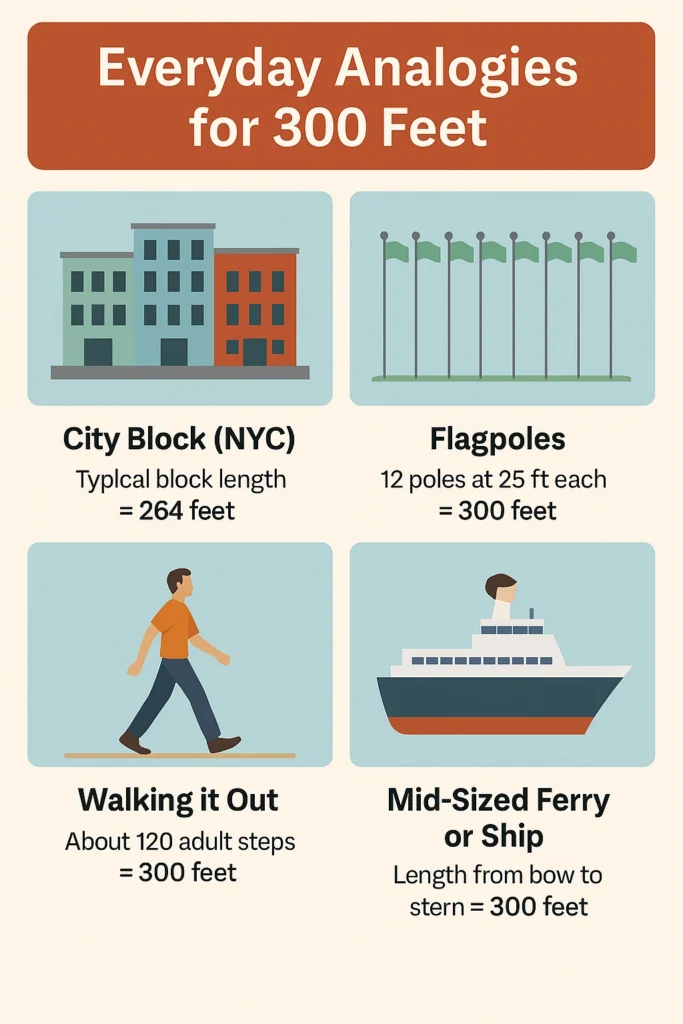
City Block Length
In cities like New York, a typical block is about 264 feet long.
Add just a bit more, and you have 300 feet. If you’ve walked a full block, you’ve nearly covered this distance already.
Line of Parked Cars
The average car is around 14 to 15 feet long.
Lining up 20 of them, bumper to bumper, creates a stretch close to 300 feet. You might see this outside stadiums or at busy shopping centers.
Flagpoles in Sequence
A standard residential flagpole stands about 20 to 25 feet tall.
Stack 12 of them straight up or picture them lined side by side. This gives a visual connection to 300 feet using something you might pass by daily.
Shopping Carts
A typical shopping cart is about 3 feet in length.
Lining up 100 carts forms a line roughly 300 feet long. It’s unlikely you’ll see that many together, but it shows scale using a familiar object.
School Buses Again
School buses are often used for scale. Lining up six to seven full-size buses provides a clean visual of 300 feet.
These rows are common during large school events or transportation hubs.
Walking It Out
The average adult step is about 2.5 feet.
Take 120 steps in a straight line, and you’ll cover around 300 feet. It’s a simple way to measure distance without any tools.
These real-life comparisons don’t require imagination. They use ordinary objects to bring 300 feet into clear focus.
300 Feet in Distance and Perception
Understanding 300 feet through measurement is one thing. But knowing how it feels or appears in real life makes it easier to visualize.
Walking Distance
At a relaxed pace, most adults walk about 3 to 4 feet per step.
It would take roughly 80 to 100 steps to walk 300 feet. This could take just under a minute on flat ground.
Running Distance
A beginner jogger can cover 300 feet in about 30 to 45 seconds, depending on pace.
For trained runners, it’s a quick burst. For others, it’s a moderate sprint.
Swimming Distance
In a standard 25-meter pool, six full lengths come close to 300 feet.
Swimmers often use this kind of workout as a warm-up or endurance drill. It’s not short, but it’s manageable.
How Far Can You See 300 Feet?
On a clear day, a person standing 300 feet away is still fully visible.
You can see their shape and posture. But finer details like facial features begin to fade. It’s the kind of range where hand gestures are visible, but small expressions are not.
Voice and Sound Perception
If someone speaks at normal volume from 300 feet away, you likely won’t hear them clearly.
In open areas, a shout might carry that far. But conversations at that distance aren’t realistic.
300 feet is just under the length of a football field. It’s a space you can walk, run, or see across, but not without feeling its size.
Who Needs to Understand 300 Feet and Why?
| Who Needs It | Why It Matters |
|---|---|
| Construction and Engineering | Used to plan building heights, crane reach, and site layouts for safety and efficiency. |
| Sports Coaches and Athletes | Helps set up training drills, mark sprint distances, and evaluate game or field setups. |
| Real Estate Professionals | Defines lot sizes, fence lines, and spacing for zoning regulations or large property sales. |
| Event Planners and Venue Managers | Used to space out stages, walkways, and crowd barriers in outdoor or stadium events. |
| Drone Operators and Hobbyists | Keeps flight paths below FAA limits, especially when estimating height visually. |
| Firefighters and Rescue Teams | Assists in planning hose length, ladder access, and operational zones during emergencies. |
Understanding what 300 feet looks like on the ground helps these professionals work more accurately, safely, and efficiently.
How many stories is 300 feet?
A typical building floor is around 10 feet tall. So 300 feet equals about 30 stories in a standard high-rise. This can vary depending on floor height, especially in commercial or luxury buildings.
Can you see 300 feet clearly?
Yes. You can see a full human figure at 300 feet, but facial features become hard to recognize. This is about the distance where shapes are visible, but details start to blur unless you use binoculars.
Is 300 feet a long walk?
Not really. Walking 300 feet takes less than a minute at a relaxed pace.
It’s similar to walking one long city block or from one side of a small parking lot to the other.
How long does it take to run 300 feet?
A beginner might take 30 to 45 seconds. An athlete could do it in 10 to 15 seconds.
Speed varies based on fitness, surface, and activity.
Is 300 feet tall for a building?
Yes. A 300-foot-tall building stands out in most city skylines, especially in mid-sized areas. It’s not a skyscraper by global standards, but it qualifies as a tall structure in most zoning codes.



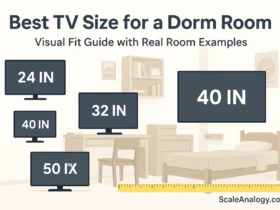
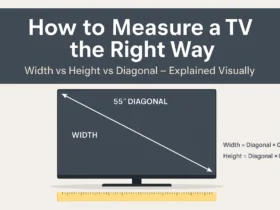



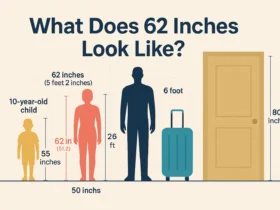
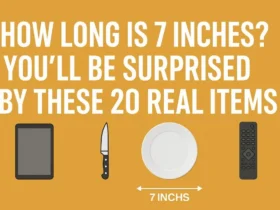


Leave a Reply